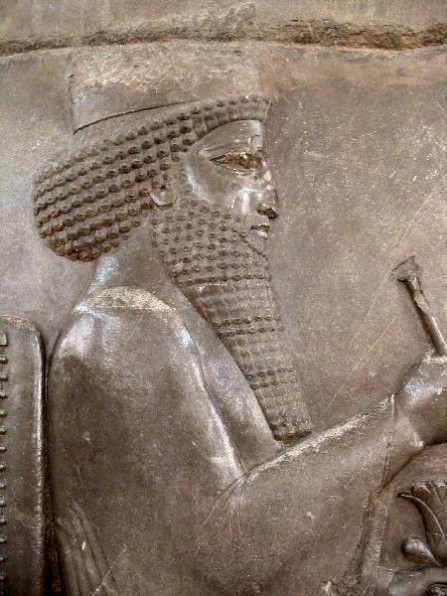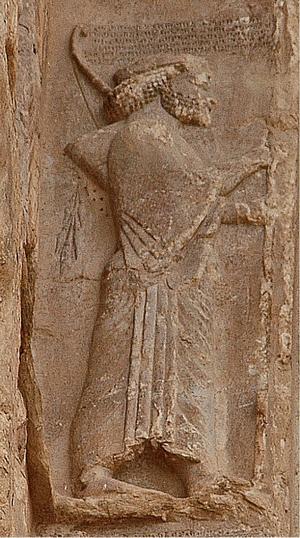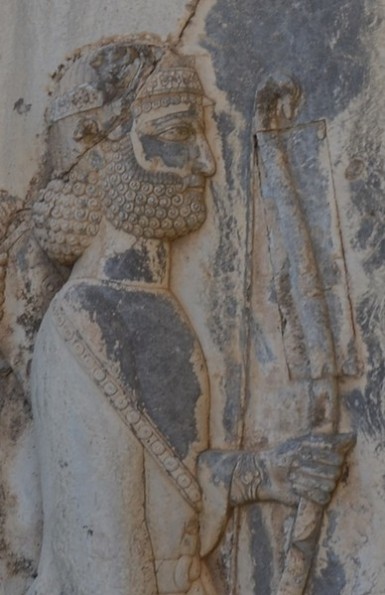Darius the Great: Dynastic Marriages
Darius I (Old Persian Dârayavauš): king of ancient Persia, whose reign lasted from 522 to 486. He seized power after killing king Gaumâta, fought a civil war (described in the Behistun inscription), and was finally able to refound the Achaemenid empire, which had been very loosely organized until then. Darius fought several foreign wars, which brought him to India and Thrace. When he died, the Persian empire had reached its largest extent. He was succeeded by his son Xerxes.

Darius was king, but the situation was difficult. To start with, the usurper Gaumâta had permitted the subject people to pay less tribute, and these nations were angry at the death of their benefactor. As Darius himself explains in the Behistun inscription:
After I had slain Gaumâta, the Magian, a certain man named ššina, the son of Upadarma, raised a rebellion in Elam, and he spoke thus unto the people of Elam: 'I am king in Elam.' Thereupon the people of Elam became rebellious, and they went over unto that ššina: he became king in Elam. ... And a certain Babylonian named Nidintu-Bêl, the son of Kîn-Zêr, raised a rebellion in Babylon: he lied to the people, saying: 'I am Nebuchadnezzar, the son of Nabonidus.' Then did all the province of Babylonia go over to Nidintu-Bêl, and Babylonia rose in rebellion. He seized on the kingdom of Babylonia.note
The first regnal year of king Nebuchadnezzar III of Babylonia is mentioned in a letter written in 3 October 522, four days after the assassination of Gaumâta. The revolt must have shocked the Persians, who were disunited anyway: not much later, a Persian nobleman named Vahyazdâta revolted against Darius. It is likely that he was one of those who had a better claim to the throne than the new ruler and felt offended now that Darius had become master of the empire. It looked as if Darius had become king of a disintegrating kingdom. Yet, he overcame these troubles, and in the year 522-521, he refounded the empire.

In the first place, he had to ally himself to the house of Cyrus and Cambyses. To be fair, he was related to these men, but from a distance: he and Cambyses had the same great-great-grandfather. No doubt, there were other Persian aristocrats who were closer related to Cambyses and Cyrus. Darius married three times to improve his position:
- Atossa (Old Persian *Utautha), a daughter of Cyrus. She had already been married to her half-brother Cambyses, but the couple did not have children. She bore Darius four sons: Xerxes (his successor), Ariamenes, Achaemenes, and Hystaspes. According to Herodotus, she was Darius' most influential queen, but she is almost absent from the Persepolis fortification tablets.
- Artystone, a younger daughter of Cyrus the Great. According to Herodotus, Irtašduna (as she is called in the Fortification tablets) was Darius' favorite wife. They had three children: Arsames, Gobryas, and Artozostre.
- Parmys (Uparmiya), the daughter of Smerdis/Bardiya. Her son was named Ariomardus.
These marriages, which must have been concluded immediately, were insufficient to ensure Darius' position. Herodotus tells the strange story that after the assassination of Gaumâta and before Darius became king, the seven conspirators discussed the future of Persia. Was it to be a monarchy, an oligarchy or a democracy? The terms of this debate clearly belong to the Greek world, but Herodotus is adamant that there was a constitutional debate indeed, and in fact, it is plausible that Darius was forced to strike a compromise with the six other conspirators. As we can deduce from various sources, they received very important positions in Darius' reborn empire.
For the moment, the most important man was probably Otanes, who is presented by Herodotus as the man who organized the conspiracy. He was a brother of Cassandane, the queen of Cyrus and mother of Cambyses. Herodotus tells that Otanes' daughter Phaedymia had been married to Cambyses and Gaumâta, which suggests that he was a very powerful man with a better claim to the throne than Darius. Otanes now gave the hand of his twice widowed daughter to Darius, and married an anonymous sister of his new son-in-law. (Otanes and Darius' sister had a daughter Amestris, who was to marry Xerxes, son of Darius and Atossa.) These marriages connected Otanes to the new king. It is very probable that the alliance was concluded in the face of the Babylonian and Elamite insurrections: Otanes sacrificed his claim to the throne to a younger and more energetic man, and demanded concessions. His descendants had a privileged status in the Achaemenid empire, although Herodotus no doubt exaggerates when he says that
to this day, the family of Otanes continues to be the only free family in Persia, and submits to the king only so far as the members of it may choose.note

A similar, fifth alliance was concluded between Darius and Gobryas, another conspirator. Darius was already married to one of Gobryas' daughters, who would give birth to Artobazanes, Ariabignes, and a daughter. After his accession, the new king married his sister Artozostre or Radušdukda to Gobryas. (Their son was Mardonius, one of Persia's most important generals in the next generation, and married to Artozostre daughter of Darius and Artystone.) Gobryas was appointed Darius' lance carrier, arštibara. In this quality, he is represented on the Behistun relief and on the relief of Darius' tomb in Naqš-e Rustam. According to the Persepolis fortification tablets, Gobryas received the largest rations in the country, which suggests that at the end of the sixth century, he was the most important man in the country after the king and crown prince.
A sixth marriage was concluded between Darius and Phratagune, the daughter of Darius' brother Artanes. As Artanes was younger than his brother, his daughter must have been too young to marry in 522. It is likely that this marriage was concluded much later.
To complete our list of royal weddings: a seventh queen was named Ardabama, who was not known to Herodotus. The Persepolis Fortification Tablets prove that she was the most powerful woman at court.
The other conspirators were, as far as we know, not connected to the Achaemenid dynasty by marriage. Nevertheless, they were important men. Hydarnes was to command an army during the winter of 522-521; his son, also called Hydarnes, became commander of the imperial guard (the famous Immortals) at the end of Darius' reign. The conspirator Megabyzus disappears from our sources, but it seems that his descendants were somehow connected to Babylon: his son Zopyrus and grandson Megabyzus are both mentioned in connection to this city. Only the further history of Ardumaniš is not known; he was not even remembered as a conspirator by Herodotus and may have died immediately after (or even during) the killing of Gaumâta.

Finally, Intaphrenes. He soon fell from grace. Although (or because) he had played a heroic role in the war against Babylon, he became a very powerful man and superseded Otanes as the second man in the empire. On the relief at Behistun, Intaphrenes is shown as the king's bow carrier, standing between Darius and the lance carrier Gobryas. Intaphrenes was, in other words, second to the king only.
However, according to Herodotus, "he failed to show proper respect for the king's authority". His story (told here) is essentially a romantic tale about a man who makes an unforgivable mistake, but it is not unconvincing. After the civil war, which will be discussed in the next part of this article, Darius' power was well-established and he no longer needed his associates. It is possible that he had started to demand more respect for his authority. Intaphrenes' fall was the prelude to the Persian autocracy.
But this happened later. In the last days of September and the first days of October 522, Darius had become king, was faced with the Babylonian and Elamite insurrections, and had allied himself to the Persian nobility. But he could not prevent anti-Persian revolts. His first regnal year was to see nineteen battles.